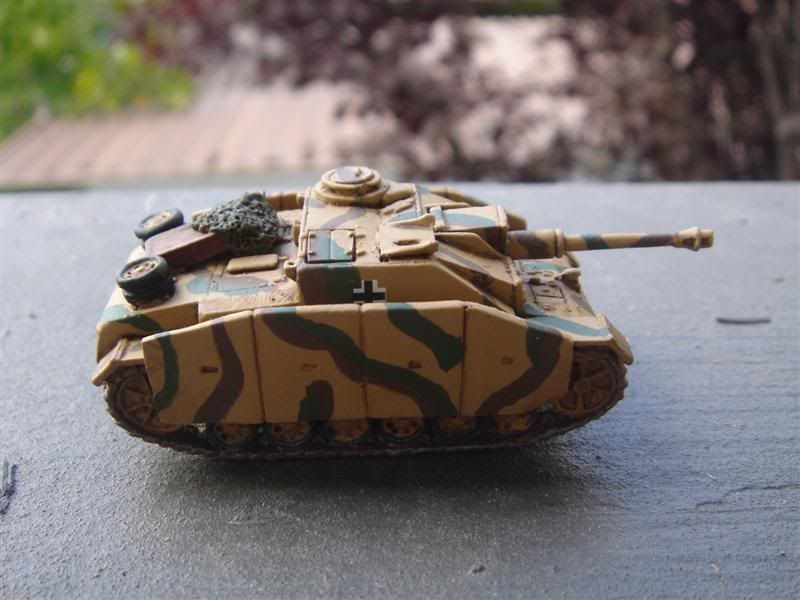 I've been working on my Fallschirmjagers quite a bit lately, including some of the vehicles I plan to use to support them. As you can probably tell from the title of this post, those will include some Sturmgeschutz IIIG assualt guns (StuGs) and SdKfz 231 armored cars (8-rads). The 8-rads are purely a point-filler for my 800 point Infantry League force. Ninety points for a pair of 8-rads is a cheap way to give my force another platoon, plus some much needed mobility. By saying that they are a point filler I mean that the choice to add them to the force was based on game rather than historical factors.
I've been working on my Fallschirmjagers quite a bit lately, including some of the vehicles I plan to use to support them. As you can probably tell from the title of this post, those will include some Sturmgeschutz IIIG assualt guns (StuGs) and SdKfz 231 armored cars (8-rads). The 8-rads are purely a point-filler for my 800 point Infantry League force. Ninety points for a pair of 8-rads is a cheap way to give my force another platoon, plus some much needed mobility. By saying that they are a point filler I mean that the choice to add them to the force was based on game rather than historical factors.The StuGs won't see use until I expand to a full 1500 or 2000 point army. Unlike the 8-rads, the StuGs are a solid historical choice for supporting my fallschirmjagers. They were often attached as support throughout the war, and in the late war period there were at least two fallschirmjager sturmgeschutz brigades.
Unlike my Soviets, which are based on forces that fought in a specific battle, my fallschirmjagers aren't based on a specific unit or point in time. Rather, they are meant to serve as any fallschirmjager unit in a European setting (east or west) from '43 to '45. More specificaly, I want them to be able to serve as both a reasonable op-force for my Soviets on the Eastern front during the mid-war, and as any of the fallschirmjager units fighting in Normandy or during Market-Garden during the late-war period.
For my vehicles this means a dunkelgelb as opposed to a dunkelgrau paint job, or so I thought. When it came to the 8-rads things actually become a bit more complicated. Whenever I start to paint a new type of unit or vehicle I try to do some research to find out the best way to do this. Most of the time this involves some web searches and the purchase of an Osprey book or similar book. In exploring 8-rads I ended up getting both and Osprey book on German armored cars and a Military Vehicles in Detail book specifically on 8-rads.
I had two main concerns, The first was whether or not to put the cow-catcher like device (called a pakschutz) on the front of the vehicle, and the second was how to paint the vehicle. My initial research based on the web and the Osprey book indicated "yes" to the pakschutz and a dunkelgelb paint job, so that's what I started with. Unfortunately, after I got the book specifically on 8-rads I discovered a few things. First, the SdKfz 231 that is sold by BattleFront actually stopped production in 1942. After that only the command model, the SdKfz 232, was produced, and that most of these appear to have been produced with thicker armor instead of the external pakschutz.
While early versions of the SdKfz 232 featured large wire frame antennas, advances in radio technology meant that later versions were very similar externally to the 231 and identical in combat performance (the difference was the better radio). As a result, it would appear that the unit in Festung Europa is actually meant to represent this model rather than the one actually listed in the book.
After finding all this out I realized that 8-rads probably either had the pakschutz or were painted dunkelgelb, but that it's quite possible that there was never an 8-rad with a pakschutz painted dunkelgelb. By the time I figured this out I had already painted the base coat on the models with the pakschutz attached, so I just decided to go with it instead of starting over. My story is that these are older 8-rads that were re-painted dunkelgelb.
As for camo, despite these being used as reconaissance vehicles, I found few pictures showing them in camo, so I decided to leave mine plain dunkelgelb.

The StuGs were a different matter. Since I plan to eventually use them as support in Normandy, I tried to find out what paint job the fallschirmjager StuGs used there. Unfortunately, I wasn't able to find any definitive sources. Instead, I ended up doing a variation on a couple different '43 and '44 camo schemes that I saw in books and photos. I also took inspiration from a picture I've seen of tank camo being applied with a mop. I figured the brush I was using was pretty close in scale to what was actually used to paint the tank, so I didn't worry too much about cleaning things up.
I don't like to do much weathering. It's probably more realistic to paint on a lot of dirt and mud, but I prefer a cleaner look to my models for the tabletop. I limited the weathering to a bit of dirt drybrushed onto the tires and mudguards. The final detail was to apply balkenkreuz decals to the sides of all the vehicles.
That should do it for my vehicular support for my fallschirmjager. Now to continue on with the infantry. I'm almost done with the first two platoons. Next up is assembling and painting a mortar platoon, probably followed by either an MG platoon, AT platoon, or 3rd infantry platoon. My goal is to eventually have all combat, weapons and non-divisional support options available for both mid and late war.




